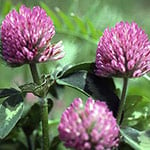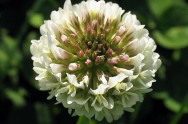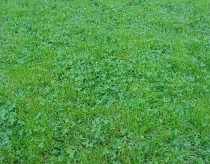How did THAT get into my lawn: Clover

 It’s a slipping hazard when wet, attracts bees, and is completely out of place visually but it wasn’t until herbicides were invented that clover became a weed and a homeowner’s enemy.
It’s a slipping hazard when wet, attracts bees, and is completely out of place visually but it wasn’t until herbicides were invented that clover became a weed and a homeowner’s enemy.
Dealing with Clover
Taking care of your lawn in a manner that promotes healthy growth and weed elimination is the best way to keep you free of clover and other pesky weeds.

Clover in the lawn
Feeling Lucky? – In Ireland, it is said if a person finds a clover with four leaves they will have good luck for as long as they carry it with them. Problem is, most clover only has three leaves and it’s taking over your lawn. This perennial weed tends to survive through grass mowing as it hugs the ground lying just lower than turf grass. The dark green leaves are shaped like shamrocks in tri-leaf clusters and have flower stems that contain pinkish-white flowers throughout the summer months.
How did THAT get into my lawn? – In the 40s and 50s clover was a common element in turf blends due to its ability to pull nitrogen from the air and make it available for your lawn. This is among the leading factors on why clover is one of the most common weeds in North America. Clover helps the lawn grow healthier because it delivers the nitrogen plants need into the soil, which is also why it appears greener than the rest of your lawn. However, despite the benefits, clover can quickly take over a lawn. It will squeeze out the grass and give your lawn an uneven look as it grows in patches and at different heights.
What can I do? – Fortunately, there are a few ways to efficiently rid your lawn of clover. The most effective way, like most weeds, is to maintain a thick and healthy turf through proper lawn maintenance. Knowing your lawn’s pH levels is key to balancing out your soil and keeping weeds from invading your lawn. Green Lawn likes to keep the lawn’s pH at 7.0 (neutral), which is why we test your levels during every visit. A balanced pH level not only keeps clover and other weeds at bay, but also improves the effectiveness of fertilizers and helps prevent the build up of thatch. In our service area, we tend to have a lot of heavy clay soils which can lead to low pH (highly acidic) lawns. Lime applications can be used to correct pH and your technician can let you know just how many will do the trick. Another effective way to eliminate clover is through the use of herbicides. Because clover grows in patches intermitent with grass it is important to use a selective broad-leaf herbicide that only attacks the clover and leaves your grass undamaged. Regular applications of weed control and fertilizer are important when eliminating weeds, Green Lawn’s full season program contains regular applications of both as well as service calls in between when necessary. An important note to remember when eliminating weeds; once the weed is gone, you will find that seed will be needed to fill the bare patches.
Read More: Spring Mowing Tips